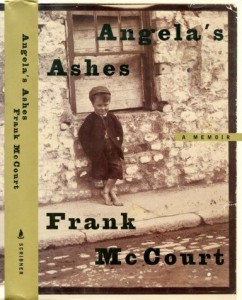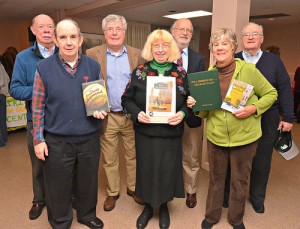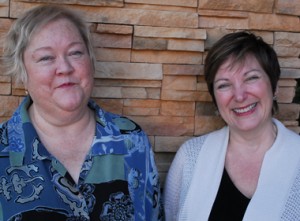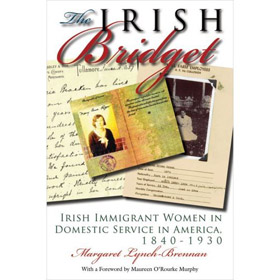One April morning in the west of Ireland, a farmer cutting turf in his bog makes a gruesome discovery: the head of a woman, face tanned like leather, with long red hair. As two experts arrive to investigate—one an Irish archeologist named Cormac Maguire and the other an American pathologist called Nora Gavin—the mystery of the ancient “bog body” becomes entangled with the recent suspicious disappearance of another woman, the wife of a local landowner, and their toddler son.
That is the premise of the debut mystery novel, “Haunted Ground,” by American writer Erin Hart. Published in 2003, this complex and evocative book was nominated for two of the top literary prizes for mysteries, the Agatha and Anthony Awards, for best first novel. Hart masterfully crafts a satisfying mystery into which she has woven strands of history, archeology, Irish folklore, and music (Cormac plays the flute and Nora is, like Hart herself, a sean nos singer). The two characters reappear in Hart’s second novel, “The Lake of Sorrows,” which likewise melds ancient and current mysteries—two bodies, murdered centuries apart, discovered in a commercial bog in Ireland’s midland county of Offaly (where Hart’s husband, two-row button accordion player, Paddy O’Brien, was born).
I recently spent a delightful hour talking on the phone with Erin Hart from her home in Minnesota, where she co-founded the Irish Music and Dance Association. The conversation ranged from what first piqued her interest in bog bodies, her longtime passion for Irish music, and why it took her almost two decades to finally write her first mystery. That last bit of information should give renewed hope to aspiring novelists who’ve been toting a killer plot in their temporal lobes but haven’t actually gotten around to writing it down. There’s time!
How did you get the idea for your first novel?
I was always interested in words and reading, but the idea of writing a book was so completely out of my sphere of possibility, until I heard a true story about two farmers out cutting turf who found the head of a red-haired girl. I was in Donegal, staying with a friend [Altan’s Daithi Sproule, who now makes his home in Minnesota] and his mother told me that her son-in-law was a famous archeologist who studied artifiacts and people found in the bogs, and his father was also an archeologist. She told me about the red-haired girl. Later, I wrote him a letter to ask him about it, and he wrote back a beautiful letter about his memory of the event, which happened when he was 9 or 10 years old. He and his father went out to the farm of the men who found the head and they had it in a biscuit tin on their kitchen table. Hs father took the tin and put it in the back seat of the car and drove back to Dublin with it. He remembered exactly what it looked like: upper teeth biting through the lower lip, the clean cut through the neck, all those wonderful, gruesome details you could use to launch a story. He told me that it “still haunts me. Forty years later, she’s still with me.’ I thought, Wow, that woman deserves a story, even if I have to make it up.
So after hearing that story, did you immediately sit down to write about it?
Well, no. [Laughing] I was looking at my journal from that time and I had written, “What a great opening for a mystery. Someone ought to write that.” Of course, I didn’t do anything with it then. The other thing I wrote was “thinking of writing a story about a red-haired girl whose head was found in a bog.” The last entry was, “Must find out more about bogs.” [Laughing.]
How did you finally do it?
When I first heard about the red-haired girl, it was the ‘80s and I was working at the Minnesota State Arts Board. One day, when I was at the copier making a gabillion news releases to send out, I thought, “I have to take a class to keep my brain alive.” When I looked into it, I had two alternatives: Get my MBA or go into creative writing, so I chose creative writing, but I decided to stick to nonfiction because you don’t have to make stuff up. I started writing all these memoir pieces about my happy childhood, and it didn’t take too long before I realized that if you had a happy childhood, no one wants to read your memoir. So I took some journalism classes and started to do some freelance work. It was good experience learning how to meet deadlines. I was freelancing for newspapers and wound up as the theater critic for the Pioneer Press in St. Paul, writing reviews and art features. My teacher at the university was the on-air theater critic for NPR, and when he moved to San Francsico, I waltzed over to NPR and said, “You don’t have a theater critic anymore and you need one.” So for five years I was theater critic for NPR. And actually, seeing all those plays, hearing all that great dialogue, and seeing how story arcs were made really helped when I sat down to write.
Were you writing the novel all that time?
No [laughing]. Actually, 10 years went by while I went to grad school, worked fulltime, and had my freelance career as a theater critic. In grad school, I took a fiction writing class, which made me feel terrified because you have to make stuff up. Then I started writing a short story and realized, hey, you can make stuff up. But after 8 years of grad school, I only had one story. I submitted it to a magazine called Glimmertrain, which was offering a nice $1,200 cash prize for new fiction. That was around 1996. I was lying in bed one morning with pneumonia and I get a phone call: “Guess what, you won the award for new writers.” I was flabbergasted. I had been lying there in bed with pneumonia, reading all these mysteries and I started thinking, “Hey, I stepped across the creek, now I think I’ll swim the ocean.” What helped push me in that direction was after I won the prize, I got calls from several agents who had read the story and were looking for new clients. Two asked me send more of my fiction work and, as you recall, I didn’t have any. I wasn’t about to say, I have all these happy childhood memoirs, so I mentioned that I had an idea for a mystery novel set in Ireland. One said, “Sounds interesting. Let me know when you finish it.” I figured I’d never hear from her again, and I didn’t. One said, “Send me 50 pages.” It took me six years to write them. It didn’t hurt that “Angela’s Ashes’ had been published. The agent told me to hurry up and finish before “Irishness goes out of fashion.” [More laughing]
How did you choose Nora and Cormac as your lead characters?
Logic. You just ask yourself, who would be interacting with an event of this type, who comes to a bog when human remains are involved: the police, the pathologist who would decide whether it’s a modern or ancient crime, and of course, definitely, an archeologist should be the hero, and probably a pathologist interested in bog remains. Originally, my lead characters were two guys so there was no element of romance, but my agent and I and had similar ideas, that they should be a man and a woman and one Irish and one American, so they would know different things and be able to educate each other and the reader.
Did you have a good sense of who they were and where the plot would take them?
In order to find out about my characters, I have to write, I can’t just sit and plot. Playwright August Wilson said that he didn’t write plays, he took dictation. I used to think that was baloney, but it’s true. Once you’re writing, your characters do things you don’t expect, and there are plot turns you don’t expect. It’s a very intuitive process. And 90 percent of the mystery writers know say that’s their experience.
Nearly all of your characters play some kind of instrument or, like Nora, sing, which makes sense given your involvement in Irish music.
I put a lot of music in it because everyone I know in Ireland is involved in music in some way. Devaney, the policeman in “Haunted Ground,” is a fiddle player, Cormac is a flute player, not an accordian player like Paddy, but Paddy is very partial to the flute. One of the farmers in the story, Fintan, plays the pipes. I was was half thinking of making Nora an unaccompanied singer and thought, nah, that would be too much. But Nora shares a job and interests with a woman who was a teacher at Trinity, Maura Delaney, a medical doctor. When I met her she mentioned something about going to a gig. I said, ‘Oh, what instrument do you play?’ and she said, ‘Oh, I don’t play, I’m a singer.’ So Nora became a singer because if it’s handed to you on a plate, you take it.
How did you meet your husband, Paddy?
He was traveling around the states and was playing in St. Paul. In 1981 I had gone to Ireland for a two-month language course in Connemara and had traveled around going to music festivals and things. The day I got home some friends said, “come down to this bar and hear this great band.” Halfway through the evening, I heard this booming voice saying, ‘And now well have a song from Erin Hart,’ and that was Paddy. My friends had told him I was a singer. He would come to town every three or four months and we’d have a date. That went on for two years and then he went home to Ireland for a while. Then he came back and moved in with me. That was in 1983, and in 1987 we got married.
Has he been a source of information for you when you’re writing your mysteries?
Paddy actually used to work on big industrial bogs as a fitter. He repaired heavy machines. I wore him out with questions. He drew me diagrams about how everything works, gave me information on shifts, the weather. In “Lake of Sorrows,” there’s a scene where there’s a peat storm, where the wind picks up the peat and whirls it around. He told me about that and the “fairy wind,” a tiny tornado of peat, that gets taken across the bog. It’s spooky and is considered a premonition of something bad happening. Then there was a really odd coincidence. We were getting ready for the “Haunted Ground” launch in Ireland and guess what, they found a new body in the bog in Offaly. They thought the body might be 2,000 years old, which is exactly what I was considering for “Lake of Sorrows.” I thought, what were the chances of this turning up exactly when I needed it? I was reading the story to Paddy about how this farmer, Kevin Barry, was surprised when he climbed out of his digger to find this body, and Paddy said, “Did you say Kevin Barry?” I said, “Yes.” He said, “I think that fellow’s my cousin.” And he was. So I was freaking out. My response was, “So, do you have his phone number?” He did and we went there for two weeks and Kevin showed us all around.
You have a third book coming out, don’t you?
I just sent the manuscript in! And I’m glad I did. I couldn’t go out in the yard without one of my neighbors screeching up and asking, “When’s the book going to be done?” I was outside the other day painting some trim and my neighbor asked me, “Why aren’t you writing?” [Laughing]
Can you tell us a little bit about it? When we last leave Nora and Cormac, she’s heading home to see her parents who are still grieving over the disappearance of her sister—Nora’s back story from “Haunted Ground”–and Cormac is going to Donegal because his father has had a stroke.
It begins in St. Paul in a place called Hidden Falls Park, which is an excellent place to hide a body. Nora is coming home on plane, remembering the details sisters’ disappearance, and Cormac is in Donegal, so it kind of takes place in both places. They talk back and forth—there are still things they have not revealed to one another. He still hasn’t told her what’s happening to his father and she doesn’t tell him about coming home and meeting the policeman she was interested in before she went to Ireland and that she’s delving into her sister’s case.
No bog bodies in this one?
Actually, that park has seepage marshes that are something like microsite bogs. Because we have freezings and thawings, extremes of temperature unlike Ireland, it’s likely people wouldn’t have remained intact. The working title of the book is “False Mermaid,” which is also the name of a plant that grows in the Mississippi and will be a botanical clue. And I think that’s all I’m going to say about it.





